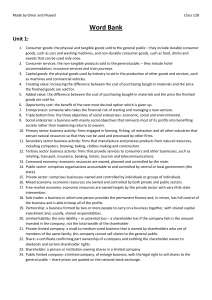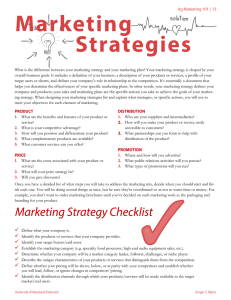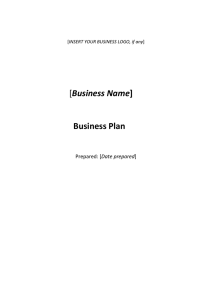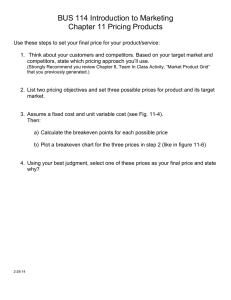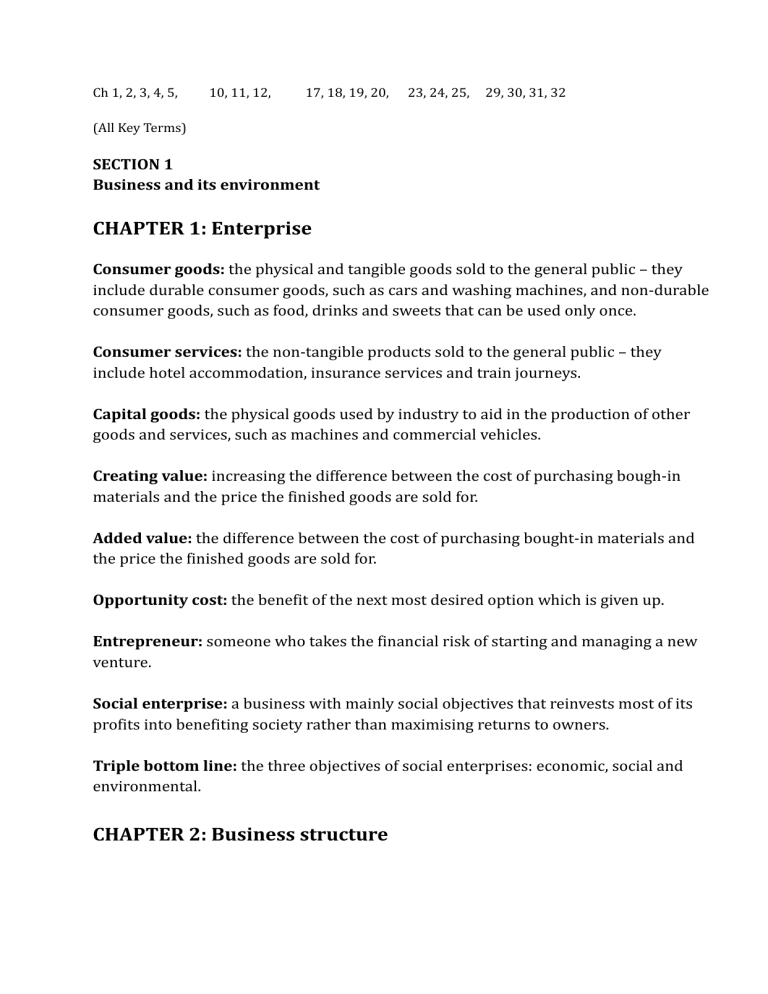
Ch 1, 2, 3, 4, 5, 10, 11, 12, 17, 18, 19, 20, 23, 24, 25, 29, 30, 31, 32 (All Key Terms) SECTION 1 Business and its environment CHAPTER 1: Enterprise Consumer goods: the physical and tangible goods sold to the general public – they include durable consumer goods, such as cars and washing machines, and non-durable consumer goods, such as food, drinks and sweets that can be used only once. Consumer services: the non-tangible products sold to the general public – they include hotel accommodation, insurance services and train journeys. Capital goods: the physical goods used by industry to aid in the production of other goods and services, such as machines and commercial vehicles. Creating value: increasing the difference between the cost of purchasing bough-in materials and the price the finished goods are sold for. Added value: the difference between the cost of purchasing bought-in materials and the price the finished goods are sold for. Opportunity cost: the benefit of the next most desired option which is given up. Entrepreneur: someone who takes the financial risk of starting and managing a new venture. Social enterprise: a business with mainly social objectives that reinvests most of its profits into benefiting society rather than maximising returns to owners. Triple bottom line: the three objectives of social enterprises: economic, social and environmental. CHAPTER 2: Business structure Primary sector business activity: firms engaged in farming, fishing, oil extraction and all other industries that extract natural resources so that they can be used and processed by other firms. Secondary sector business activity: firms that manufacture and process products from natural resources, including computers, brewing, baking, clothes-making and Construction. Tertiary sector business activity: firms that provide services to consumers and other businesses, such as retailing, transport, insurance, banking, hotels, tourism and Telecommunications. Public sector: comprises organisations accountable to and controlled by central or local government (the state). Private sector: comprises businesses owned and controlled by individuals or groups of individuals. Mixed economy: economic resources are owned and controlled by both private and public sectors. Free-market economy: economic resources are owned largely by the private sector with very little state intervention. Command economy: economic resources are owned, planned and controlled by the state. Sole trader: a business in which one person provides the permanent finance and, in return, has full control of the business and is able to keep all of the profits. Partnership: a business formed by two or more people to carry on a business together, with shared capital investment and, usually, shared responsibilities Limited liability: the only liability – or potential loss – a shareholder has if the company fails is the amount invested in the company, not the total wealth of the shareholder. Private limited company: a small to medium-sized business that is owned by shareholders who are often members of the same family; this company cannot sell shares to the general public. Share: a certificate confirming part ownership of a company and entitling the shareholder owner to dividends and certain shareholder rights. Shareholder: a person or institution owning shares in a limited company Public limited company: a limited company, often a large business, with the legal right to sell shares to the general public – share prices are quoted on the national stock exchange. Memorandum of Association: this states the name of the company, the address of the head off ice through which it can be contacted, the maximum share capital for which the company seeks authorisation and the declared aims of the business. Articles of Association: this document covers the internal workings and control of the business – for example, the names of directors and the procedures to be followed at meetings will be detailed. Franchise: a business that uses the name, logo and trading systems of an existing successful business. Joint venture: two or more businesses agree to work closely together on a particular project and create a separate business division to do so. Holding company: a business organisation that owns and controls a number of separate businesses, but does not unite them into one unified company. Public corporation: a business enterprise owned and controlled by the state – also known as nationalised industry. CHAPTER 3: Size of business Revenue: total value of sales made by a business in a given time period. Capital employed: the total value of all long-term finance invested in the business. Market capitalisation: the total value of a company’s issued shares. Market share: sales of the business as a proportion of total market sales. Internal growth: expansion of a business by means of opening new branches, shops or factories (also known as organic growth). CHAPTER 4: Business objectives Mission statement: a statement of the business’s core aims, phrased in a way to motivate employees and to stimulate interest by outside groups. Corporate social responsibility: this concept applies to those businesses that consider the interests of society by taking responsibility for the impact of their decisions and activities on customers, employees, communities and the environment. Management by objectives: a method of coordinating and motivating all staff in an organisation by dividing its overall aim into specific targets for each department, manager and employee. Ethical code (code of conduct): a document detailing a company’s rules and guidelines on staff behaviour that must be followed by all employees. CHAPTER 5: Stakeholders in a business Stakeholders: people or groups of people who can be affected by – and therefore have an interest in – any action by an organisation. Stakeholder concept: the view that businesses and their managers have responsibilities to a wide range of groups, not just shareholders. Corporate social responsibility: the concept that accepts that businesses should consider the interests of society in their activities and decisions, beyond the legal obligations that they have. SECTION 2 Human resource managment CHAPTER 10: Human resource management Human resource management (HRM): the strategic approach to the effective management of an organisation’s workers so that they help the business gain a competitive advantage. Recruitment: the process of identifying the need for a new employee, defining the job to be filled and the type of person needed to fill it and attracting suitable candidates for the job. Selection: involves the series of steps by which the candidates are interviewed, tested and screened for choosing the most suitable person for vacant post. Job description: a detailed list of the key points about the job to be filled – stating all its key tasks and responsibilities Person specification: a detailed list of the qualities, skills and qualifications that a successful applicant will need to have. Employment contract: a legal document that sets out the terms and conditions governing a worker’s job. Labour turnover: measures the rate at which employees are leaving an organisation. It is measured by: number of employees leaving in 1 year / average number of people employed x 100 Training: work-related education to increase workforce skills and efficiency. Induction training: introductory training programme to familiarise new recruits with the systems used in the business and the layout of the business site. On-the-job training: instruction at the place of work on how a job should be carried out. Off -the-job training: all training undertaken away from the business, e.g. work-related college courses. Employee appraisal: the process of assessing the eff ectiveness of an employee judged against pre-set objectives. Dismissal: being dismissed or sacked from a job due to incompetence or breach of discipline. Unfair dismissal: ending a worker’s employment contract for a reason that the law regards as being unfair. Redundancy: when a job is no longer required, the employee doing this job becomes unnecessary through no fault of their own. Work–life balance: a situation in which employees are able to give the right amount of time and eff ort to work and to their persona Equality policy: practices and processes aimed at achieving a fair organisation where everyone is treated in the same way and has the opportunity to fulfil their Potential. Diversity policy: practices and processes aimed at creating a mixed workforce and placing positive value on diversity in the workplace. CHAPTER 11: Motivation Motivation: the internal and external factors that stimulate people to take actions that lead to achieving a goal. Self-actualisation: a sense of self-fulfilment reached by feeling enriched and developed by what one has learned and achieved. Motivating factors (motivators): aspects of a worker’s job that can lead to positive job satisfaction, such as achievement, recognition, meaningful and interesting work and advancement at work. Hygiene factors: aspects of a worker’s job that have the potential to cause dissatisfaction, such as pay, working conditions, status and over-supervision by managers. Job enrichment: aims to use the full capabilities of workers by giving them the opportunity to do more challenging and fulfilling work. Time based wage rate: payment to a worker made for each period of time worked, e.g. one hour. Piece rate: a payment to a worker for each unit produced. Salary: annual income that is usually paid on a monthly basis. Commission: a payment to a sales person for each sale made. Bonus: a payment made in addition to the contracted wage or salary. Performance-related pay: a bonus scheme to reward staff for above-average work performance Profit sharing: a bonus for staff based on the profits of the business – usually paid as a proportion of basic salary. Fringe benefits: benefits given, separate from pay, by an employer to some or all employees. Job rotation: increasing the flexibility of employees and the variety of work they do by switching from one job to another. Job enlargement: attempting to increase the scope of a job by broadening or deepening the tasks undertaken. Job redesign: involves the restructuring of a job – usually with employees’ involvement and agreement – to make work more interesting, satisfying and challenging. Quality circles: voluntary groups of workers who meet regularly to discuss work-related problems and issues. Worker participation: workers are actively encouraged to become involved in decision-making within the organisation. Team-working: production is organised so that groups of workers undertake complete units of work. CHAPTER 12: Management Manager: responsible for setting objectives, organising resources and motivating staff so that the organisation’s aims are met. Leadership: the art of motivating a group of people towards achieving a common objective. Autocratic leadership: a style of leadership that keeps all decision-making at the centre of the organisation. Democratic leadership: a leadership style that promotes the active participation of workers in taking decisions. Paternalistic leadership: a leadership style based on the approach that the manager is in a better position than the workers to know what is best for an organisation. Laissez-faire leadership: a leadership style that leaves much of the business decision-making to the workforce – a ‘hands-off ’ approach and the reverse of the autocratic style. Informal leader: a person who has no formal authority but has the respect of colleagues and some power over them. Emotional intelligence (EI): the ability of managers to understand their own emotions, and those of the people they work with, to achieve better business performance. SECTION 3 Marketing CHAPTER 17: The nature of marketing Marketing: the management task that links the business to the customer by identifying and meeting the needs of customers profitably – it does this by getting the right product at the right price to the right place at the right time. Marketing objectives: the goals set for the marketing department to help the business achieve its overall Objectives. Marketing strategy: long-term plan established for achieving marketing objectives. Market orientation: an outward-looking approach basing product decisions on consumer demand, as established by market research. Product orientation: an inward-looking approach that focuses on making products that can be made – or have been made for a long time – and then trying to sell them. Asset-led marketing: an approach to marketing that bases strategy on the firm’s existing strengths and assets instead of purely on what the customer wants. Societal marketing: this approach considers not only the demands of consumers but also the effects on all members of the public (society) involved in some way when firms meet these demands. Demand: the quantity of a product that consumers are willing and able to buy at a given price in a time period. Supply: the quantity of a product that firms are prepared to supply at a given price in a time period. Equilibrium price: the market price that equates supply and demand for a product Market size: the total level of sales of all producers within a market. Market growth: the percentage change in the total size of a market (volume or value) over a period of time. Market share: the percentage of sales in the total market sold by one business. This is calculated by the following formula: firm’s sales in time period divided by total market sales in time period × 100 Direct competitor: businesses that provide the same or very similar goods or services. USP − unique selling point (or proposition): the special feature of a product that differentiates it from competitors’ Products. Product differentiation: making a product distinctive so that it stands out from competitors’ products in consumers’ perception. Niche marketing: identifying and exploiting a small segment of a larger market by developing products to suit it. Mass marketing: selling the same products to the whole market with no attempt to target groups within it. Market segment: a sub-group of a whole market in which consumers have similar characteristics. Market segmentation: identifying different segments within a market and targeting different products or services to them. Consumer profile: a quantified picture of consumers of a firm’s products, showing proportions of age groups, income levels, location, gender and social class. CHAPTER 18: Market research Market research: this is the process of collecting, recording and analysing data about customers, competitors and the market. Primary research: the collection of first-hand data that is directly related to a firm’s needs. Secondary research: collection of data from secondhand sources. Qualitative research: research into the in-depth motivations behind consumer buying behaviour or opinions. Quantitative research: research that leads to numerical results that can be statistically analysed. Focus groups: a group of people who are asked about their attitude towards a product, service, advertisement or new style of packaging Sample: the group of people taking part in a market research survey selected to be representative of the overall target market. Random sampling: every member of the target population has an equal chance of being selected. Systematic sampling: every nth item in the target population is selected. Stratified sampling: this draws a sample from a specified sub-group or segment of the population and uses random sampling to select an appropriate number from each stratum. Quota sampling: when the population has been stratified and the interviewer selects an appropriate number of respondents from each stratum. Cluster sampling: using one or a number of specific groups to draw samples from and not selecting from the whole population, e.g. using one town or region. Open questions: those that invite a wide-ranging or imaginative response – the results will be difficult to collate and present numerically. Closed questions: questions to which a limited number of pre-set answers is off ered. Arithmetic mean: calculated by totalling all the results and dividing by the number of results. Mode: the value that occurs most frequently in a set of data. Median: the value of the middle item when data have been ordered or ranked. It divides the data into two equal parts. Range: the difference between the highest and lowest value. Inter-quartile range: the range of the middle 50% of the data. CHAPTER 19: The marketing mix - product and price Marketing mix: the four key decisions that must be taken in the effective marketing of a product. Customer relationship management (CRM): using marketing activities to establish successful customer relationships so that existing customer loyalty can be maintained. Brand: an identifying symbol, name, image or trademark that distinguishes a product from its competitors. Intangible attributes of a product: subjective opinions of customers about a product that cannot be measured or compared easily. Tangible attributes of a product: measurable features of a product that can be easily compared with other products. Product: the end result of the production process sold on the market to satisfy a customer need. Product positioning: the consumer perception of a product or service as compared to its competitors Product portfolio analysis: analysing the range of existing products of a business to help allocate resources effectively between them. Product life cycle: the pattern of sales recorded by a product from launch to withdrawal from the market and is one of the main forms of product portfolio analysis. Consumer durable: manufactured product that can be reused and is expected to have a reasonably long life, such as a car or washing machine. Extension strategies: these are marketing plans to extend the maturity stage of the product before a brand new one is needed. Price elasticity of demand: measures the responsiveness of demand following a change in price. Mark-up pricing: adding a fixed mark-up for profit to the unit price of a product Target pricing: setting a price that will give a required rate of return at a certain level of output/sales. Full-cost pricing: setting a price by calculating a unit cost for the product (allocated fixed and variable costs) and then adding a fixed profit margin. Contribution-cost pricing: setting prices based on the variable costs of making a product in order to make a contribution towards fixed costs and profit. Competition-based pricing: a firm will base its price upon the price set by its competitors. Dynamic pricing: offering goods at a price that changes according to the level of demand and the customer’s ability to pay. Penetration pricing: setting a relatively low price often supported by strong promotion in order to achieve a high volume of sales. Market skimming: setting a high price for a new product when a firm has a unique or highly differentiated product with low price elasticity of demand. CHAPTER 20: The marketing mix - promotion and place Promotion: the use of advertising, sales promotion, personal selling, direct mail, trade fairs, sponsorship and public relations to inform consumers and persuade them to buy. Promotion mix: the combination of promotional techniques that a firm uses to sell a product. Above-the-line promotion: a form of promotion that is undertaken by a business by paying for communication with consumers. Advertising: paid-for communication with consumers to inform and persuade, e.g. TV and cinema advertising. Below-the-line promotion: promotion that is not a directly paid-for means of communication, but based on short-term incentives to purchase. Sales promotion: incentives such as special off ers or special deals directed at consumers or retailers to achieve short-term sales increases and repeat purchases by consumers. Personal selling: a member of the sales staff communicates with one consumer with the aim of selling the product and establishing a long-term relationship between company and consumer. Sponsorship: payment by a company to the organisers of an event or team/individuals so that the company name becomes associated with the event/team/individual. Public relations: the deliberate use of free publicity provided by newspapers, TV and other media to communicate with and achieve understanding by the public. Branding: the strategy of differentiating products from those of competitors by creating an identifiable image and clear expectations about a product. Marketing or promotion budget: the financial amount made available by a business for spending on marketing/ promotion during a certain time period. Channel of distribution: this refers to the chain of intermediaries a product passes through from producer to final consumer. Internet (online) marketing: refers to advertising and marketing activities that use the Internet, email and mobile communications to encourage direct sales via electronic Commerce. E-commerce: the buying and selling of goods and services by businesses and consumers through an electronic medium. Viral marketing: the use of social media sites or text messages to increase brand awareness or sell products. Integrated marketing mix: the key marketing decisions complement each other and work together to give customers a consistent message about the product. SECTION 4 Operations management CHAPTER 23: The nature of operations Added value: the difference between the cost of purchasing raw materials and the price the finished goods are sold for – this is the same as creating value. Intellectual capital: intangible capital of a business that includes human capital (well trained and knowledgeable employees), structural capital (databases and information systems) and relational captial (good links with supplier and customers). Production: converting inputs into outputs. Level of production: the number of units produced during a time period. Productivity: the ratio of outputs to inputs during production, e.g. output per worker per time period. Efficiency: producing output at the highest ratio of output to input. Effectiveness: meeting the objectives of the enterprise by using inputs productively to meet customers’ needs. Labour intensive: involving a high level of labour input compared with capital equipment. Capital intensive: involving a high quantity of capital equipment compared with labour input. CHAPTER 24: Inventory management Inventory (stock): materials and goods required to allow for the production and supply of products to the customer Economic order quantity: the optimum or least-cost quantity of stock to re-order taking into account delivery costs and stock-holding costs. Buffer inventories: the minimum inventory level that should be held to ensure that production could still take place should a delay in delivery occur or should production rates increase. Re-order quantity: the number of units ordered each time. Lead time: the normal time taken between ordering new stocks and their delivery. Just-in-time: this inventory-control method aims to avoid holding inventories by requiring supplies to arrive just as they are needed in production and completed products are produced to order. CHAPTER 25: Capacity utilisation and outsourcing Capacity utilisation: the proportion of maximum output capacity currently being achieved. Excess capacity: exists when the current levels of demand are less than the full capacity output of a business – also known as spare capacity. Rationalisation: reducing capacity by cutting overheads to increase eff iciency of operations, such as closing a factory or off ice department, oft en involving redundancies. Full capacity: when a business produces at maximum output. Capacity shortage: when the demand for a business’s products exceeds production capacity. Outsourcing: using another business (a ‘third party’) to undertake a part of the production process rather than doing it within the business using the firm’s own employees. Business-process outsourcing (BPO): a form of outsourcing that uses a third party to take responsibility for certain business functions, such as HR and finance. SECTION 5 Finance and accounting CHAPTER 29: Business finance Start-up capital: the capital needed by an entrepreneur to set up a business. Working capital: the capital needed to pay for raw materials, day-to-day running costs and credit off ered to customers. In accounting terms working capital = current assets – current liabilities. Capital expenditure: the purchase of assets that are expected to last for more than one year, such as building and machinery. Revenue expenditure: spending on all costs and assets other than fixed assets and includes wages and salaries and materials bought for stock. Liquidity: the ability of a firm to be able to pay its shortterm debts. Liquidation: when a firm ceases trading and its assets are sold for cash to pay suppliers and other creditors. Overdraft : bank agrees to a business borrowing up to an agreed limit as and when required. Factoring: selling of claims over trade receivables to a debt factor in exchange for immediate liquidity – only a proportion of the value of the debts will be received as cash Hire purchase: an asset is sold to a company that agrees to pay fixed repayments over an agreed time period – the asset belongs to the company. Leasing: obtaining the use of equipment or vehicles and paying a rental or leasing charge over a fixed period, this avoids the need for the business to raise long-term capital to buy the asset; ownership remains with the leasing company. Equity finance: permanent finance raised by companies through the sale of shares. Long-term loans: loans that do not have to be repaid for at least one year. Long-term bonds or debentures: bonds issued by companies to raise debt finance, often with a fixed rate of interest. Rights issue: existing shareholders are given the right to buy additional shares at a discounted price. Venture capital: risk capital invested in business start-ups or expanding small businesses that have good profit potential but do not find it easy to gain finance from other sources. Microfinance: providing financial services for poor and low-income customers who do not have access to banking services, such as loans and overdraft s offered by traditional commercial banks. Crowd funding: the use of small amounts of capital from a large number of individuals to finance a new business venture Business plan: a detailed document giving evidence about a new or existing business, and that aims to convince external lenders and investors to extend finance to the business. CHAPTER 30: Forecasting and managing cash flows Cash flow: the sum of cash payments to a business (inflows) less the sum of cash payments (outflows). Liquidation: when a firm ceases trading and its assets are sold for cash to pay suppliers and other creditors. Insolvent: when a business cannot meet its short-term debts. Cash inflows: payments in cash received by a business, such as those from customers (trade receivables) or from the bank, e.g. receiving a loan. Cash outflows: payments in cash made by a business, such as those to suppliers and workers. Cash-flow forecast: estimate of a firm’s future cash inflows and outflows. Net monthly cash flow: estimated difference between monthly cash inflows and cash outflows. Opening cash balance: cash held by the business at the start of the month. Closing cash balance: cash held at the end of the month becomes next month’s opening balance. Credit control: monitoring of debts to ensure that credit periods are not exceeded. Bad debt: unpaid customers’ bills that are now very unlikely to ever be paid. Overtrading: expanding a business rapidly without obtaining all of the necessary finance so that a cash-flow shortage develops. Creditors: suppliers who have agreed to supply products on credit and who have not yet been paid. CHAPTER 31: Costs Direct costs: these costs can be clearly identified with each unit of production and can be allocated to a cost centre. Indirect costs: costs that cannot be identified with a unit of production or allocated accurately to a cost centre Fixed costs: costs that do not vary with output in the short run. Variable costs: costs that vary with output. Marginal costs: the extra cost of producing one more unit of output. Break-even point of production: the level of output at which total costs equal total revenue, neither a profit nor a loss is made. Margin of safety: the amount by which the sales level exceeds the break-even level of output Contribution per unit: selling price less variable cost per unit. CHAPTER 32: Budgets Budget: a detailed financial plan for the future. Budget holder: individual responsible for the initial setting and achievement of a budget. Variance analysis: calculating differences between budgets and actual performance, and analysing reasons for such differences. Delegated budgets: giving some delegated authority over the setting and achievement of budgets to junior managers. Incremental budgeting: uses last year’s budget as a basis and an adjustment is made for the coming year. Zero budgeting: setting budgets to zero each year and budget holders have to argue their case to receive any finance. Flexible budgeting: cost budgets for each expense are allowed to vary if sales or production vary from budgeted levels. Adverse variance: exists when the difference between the budgeted and actual figure leads to a lower-than-expected profit. Favourable variance: exists when the difference between the budgeted and actual figure leads to a higherthan- expected profit.




